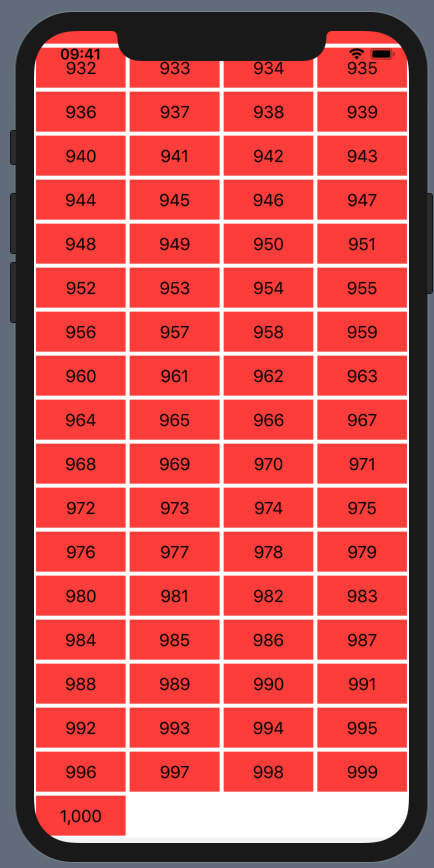CollectionView in SwiftUI
Yeah, the title is a little bit a clickbait because you probably know, it doesn’t exist. This article will be a little bit my point of view on how to implement grid collectionView in SwiftUI. Yes, there are few options, but probably everyone has a disadvantage.
3rd party lirbary
A few days ago I have seen in one project ASCollectionView to implement a simple Grid layout. My first idea was “Why?”. I don’t think libraries are bad, but … it can bring more complications in the future, it shouldn’t fit your case and usually, you wait for someone to fix some magic issue and many more. And in the end, this solution is just UICollectionView with UIViewRepresentable, so you can implement it in your way.
UICollectionView with UIViewRepresentable
If you know something in UIKit and you can’t find an ideal solution in SwiftUI, you probably can use UIViewRepresentable.
struct CollectionView {
@State var cellTypes: [(type: AnyClass?, reuseIdentifier: String)]
@State var dataSource: UICollectionViewDataSource? = nil
@State var delegate: UICollectionViewDelegate? = nil
}
// MARK: - UIViewRepresentable
extension CollectionView: UIViewRepresentable {
typealias UIViewType = UICollectionView
func makeUIView(context: UIViewRepresentableContext<CollectionView>) -> CollectionView.UIViewType {
let collectionView = UICollectionView()
cellTypes.forEach { (type, reuseIdentifier) in
collectionView.register(type, forCellWithReuseIdentifier: reuseIdentifier)
}
collectionView.dataSource = dataSource
collectionView.delegate = delegate
return collectionView
}
func updateUIView(_ uiView: UICollectionView, context: UIViewRepresentableContext<CollectionView>) { }
}
The disadvantage of this solution is, it is not SwiftUI and UICollectionViewDataSource is NSObjectProtocol. Probably when you decide for SwiftUI you don’t want UIKit in your app if it is not required.
SwiftUI way
As I said at the beginning of this article, SwiftUI way for CollectionView doesn’t exist. Wait minute, we can try to create it. Here is my way. At first, I create some helper a wrapper for Cell in collectionView.
private struct Cell: View, Identifiable {
/// Unique ID
var id: Int
var body: some View {
AnyView(content)
}
init<T: View>(
_ content: T,
_ index: Int
) {
self.id = index
self.content = AnyView(content)
}
/// Empty cell
init() {
self.id = UUID().hashValue
self.content = AnyView(Rectangle().foregroundColor(.clear))
}
private let content: AnyView
}
extension Cell: Hashable {
static func == (lhs: Cell, rhs: Cell) -> Bool {
lhs.id == rhs.id
}
func hash(into hasher: inout Hasher) {
hasher.combine(id)
}
}
In the view init separate content values to rows and make little bit magic to add empty cells to the last row if it is needed because every row must have the same number of cells.
struct ColumnList<Value: View>: View {
var body: some View { ... }
init(
colums: Int,
content: [Value]
) {
var collection: [[Cell]] = .init()
// Add additional cells
var rows = content.count / colums
if content.count % colums > 0 {
rows += 1
}
// Create row
for rowIndex in 0..<rows {
// Count offset for current row
let offset = rowIndex * colums
// Create cells in row
var row: [Cell] = .init()
for columIndex in 0..<colums {
let index = offset + columIndex
if index < content.count {
row.append(
Cell(content[index], index)
)
}
}
collection.append(row)
}
// Add clear cells to additional row
if content.count % colums > 0 {
var lastRow = collection.removeLast()
let lastRowCells = content.count % colums
for _ in 0..<(colums - lastRowCells) {
lastRow.append(Cell())
}
collection.append(lastRow)
}
self.content = collection
}
// MARK: - Private properties
private let content: [[Cell]]
}
Final part is implemented View body, and is there two ways. First, it is with ScrollView, it looks very nice, is simple but is there a memory issue. When you have a lot of cells, for example, you want to show all your 1000 songs, your app will crash for low memory.
ScrollView(.vertical) {
VStack(spacing: 0) {
ForEach(content, id: \.self) { row in
HStack(spacing: 0) {
ForEach(row, id: \.self) { $0 }
}
}
}
}
The second option is to replace ScrollView with List. But this solution has a disadvantage - cell separator. I did resolved it with UITableView.appearance().separatorStyle = .none, but I think it is little bit big side effect, because it applies to everyone’s new List.
List {
ForEach(content, id: \.self) { row in
HStack(spacing: 0) {
ForEach(row, id: \.self) { $0 }
}
}
.listRowInsets(.init())
}
.onAppear {
// Side efect :(
UITableView.appearance().separatorStyle = .none
}
Here is my preview if you want to try it.
struct ColumnList_Previews: PreviewProvider {
private struct Element: View {
let element: Int
var body: some View {
ZStack {
Rectangle()
.frame(height: 40)
.foregroundColor(.red)
.padding(2)
Text("\(element)")
}
}
}
static var previews: some View {
let elements = (0..<1001)
.map(Element.init(element:))
return ColumnList(colums: 4, content: elements) {
print("Last row appear")
}
}
}

In the end
To sum up, CollectionView didn’t exist in the SwiftUI world without a disadvantage. This is reality. When I should implement CollectionView with a small number of cells I will decide for clear SwiftUI implementation with ScrollView, and for more cells, I will decide for List. You can choose any one of my solutions, I can not say which is the best (or the worst) for you, it really depends only on your case and which way you prefer.
PS: If you know about better solution (or just other 😅) feel free to write me.